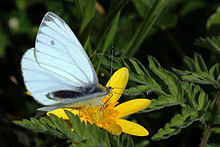Pieris napi
| Green-veined white | |
|---|---|
 |
|
 |
|
| Both images from Wytham Woods, Oxfordshire, England | |
| Scientific classification | |
| Kingdom: | Animalia |
| Phylum: | Arthropoda |
| Class: | Insecta |
| Order: | Lepidoptera |
| Family: | Pieridae |
| Genus: | Pieris |
| Species: | P. napi |
| Binomial name | |
|
Pieris napi (Linnaeus, 1758) |
|
The green-veined white (Pieris napi) is a butterfly of the family Pieridae.
A circumboreal species widespread across Europe and Asia, including the Indian subcontinent, Japan, the Maghreb and North America. It is found in meadows, hedgerows and woodland glades but not as often in gardens and parks like its close relatives the large and small whites, for which it is often mistaken. Like other "white" butterflies, the sexes differ. The female has two spots on each forewing, the male only one. The veins on the wings of the female are usually more heavily marked. The underside hindwings are pale yellow with the veins highlighted by black scales giving a greenish tint, hence green-veined white. Unlike the large and small whites, it rarely chooses garden cabbages to lay its eggs on, preferring wild crucifers. Males emit a sex pheromone that is perceptible to humans, citral, the basic flavor-imparting component of lemon peel oil.
Some authors consider the mustard white and West Virginia white of North America to be conspecific with P. napi or consider P. napi to be a superspecies. Despite this, the American butterflies, unlike P. napi, cannot successfully use garlic mustard as a host plant. Females will lay eggs on it, mistaking this non-native species for a compatible native mustard, resulting in the death of the offspring. Classification is also an issue concerning the European dark-veined white.
The eggs are laid singly on a wide range of food plants including hedge mustard (Sisybrium officinale), garlic mustard (Alliaria petiolata), cuckooflower (Cardamine pratense), water-cress (Rorippa nastutium-aquaticum), charlock (Sinapis arvensis), large bitter-cress (Cardamine amara), wild cabbage (Brassica oleracea), and wild radish (Raphanus raphanistrum), and so it is rarely a pest in gardens or field crops. The caterpillar is green and well camouflaged. When full grown it is green above with black warts, from which arise whitish and blackish hairs. There is a darker line along the back and a yellow line low down on the sides. Underneath the colour is whitish-grey. The spiracular line is dusky but not conspicuous, and the spiracles are blackish surrounded with yellow. There is extensive overlap with other leaf-feeding larvae of large and small whites in some wild populations (e.g. in Morocco). It is often found feeding on the same plant as the orange tip but rarely competes for food because it usually feeds on the leaves whereas the orange tip caterpillar feeds on the flowers and developing seed pods. Like other Pieris species it overwinters as a pupa. This is green in colour, and the raised parts are yellowish and brown. This is the most frequent form, but it varies through yellowish to buff or greyish, and is sometimes without markings.
...
Wikipedia
